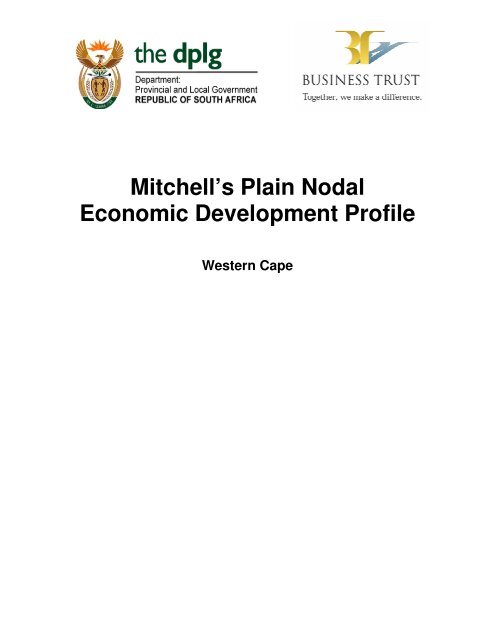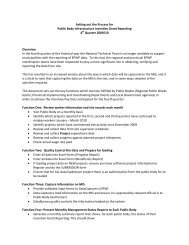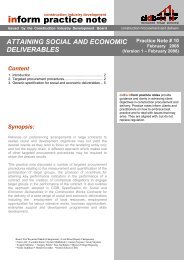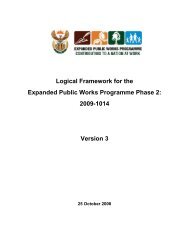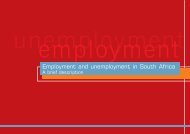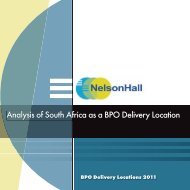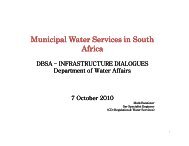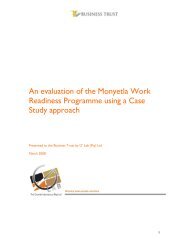Mitchell's Plain Nodal Economic Development Profile - Business Trust
Mitchell's Plain Nodal Economic Development Profile - Business Trust
Mitchell's Plain Nodal Economic Development Profile - Business Trust
- No tags were found...
Create successful ePaper yourself
Turn your PDF publications into a flip-book with our unique Google optimized e-Paper software.
Mitchell’s <strong>Plain</strong> <strong>Nodal</strong><strong>Economic</strong> <strong>Development</strong> <strong>Profile</strong>Western Cape
Table of ContentsSection 1:Introduction............................................................................................3Section 2: An Overview of Mitchell’s <strong>Plain</strong> .............................................................4Section 3:The Economy of Mitchell’s <strong>Plain</strong>............................................................7Section 4: Enabling Environment ...........................................................................9Section 5: <strong>Economic</strong> Growth and Investment Opportunities ................................10Section 6:Summary.............................................................................................142
Section 2: An Overview of Mitchell’s <strong>Plain</strong>2.1 AdministrationMitchell’s <strong>Plain</strong> was created in the 1970s to alleviate housing shortages in thecoloured community of Cape Town when communities were forcefully removedand/or relocated in terms of apartheid legislation. It was planned as a segregated,self-sufficient dormitory suburb far removed from the white areas of the city, but alsoisolated from the black and Indian communities. All manufacturing and industrialactivity was excluded from the area in order to promote Atlantis, an industrialdecentralisation area 45km to the north of Cape Town. Mitchell’s <strong>Plain</strong> was built toaccommodate 250 000 people, but the current population of the area far exceedsthis number.2.2 Spatial informationSub-areas• Sub-areas include Strandfontein, Rocklands, Tafelsig, Westridge, Portland,Beacon Valley, Lentegeur, Woodlands and Weltevreden Valley.Transportation• A large proportion of residents make use of public transport including buses,trains and taxis.• <strong>Mitchell's</strong> <strong>Plain</strong> is the third-busiest modal interchange in the City of Cape Town,with about 75 000 commuters in the morning and evening peak hours.Terrain and natural resources• The terrain is flat and sandy.2.3 Socio-economic informationThe socio-economic character of Mitchell’s <strong>Plain</strong> is described below.Population• The population numbers approximately 398 650 people living in an area110,2km 2 in size, most of it urban. The population density is 3 618 persons/km 2 .• Some 22% of households live in informal houses.• About 58% of households comprise four persons or more.• Approximately 62% of the population are younger than 29 years of age.• Afrikaans is spoken by 40% of the population, with IsiXhosa and Englishaccounting for about 30% each.Infrastructure and services• Households without access to basic services are as follows: 18% are withoutelectricity, 13% are without piped water, 11% are without waste removal servicesand 41% are without telephone services.4
• There are 15 secondary and 43 primary schools, and 53 early childhooddevelopment centres.Income and employment• About 48% of households live below the poverty line; however, the averagemonthly income of the node is only slightly lower than the national average.• Only 43% of the working age population are employed.Education• Very few people in Mitchell’s <strong>Plain</strong> have access to higher education.• Almost 40% of people aged 5 to 24 do not attend school. The most importantreasons provided for leaving school are either to work or to look for work.Health care• All communities are within 2,5 km of a primary health care clinic.• Per capita health expenditure in 2001 amounted to R357.• There are plans to build two regional hospitals, one each in Khayelitsha andMitchell’s <strong>Plain</strong>, in 2006/2007.• Insufficient HIV and AIDS-prevention programmes are running at present due tostaff shortages. AIDS-awareness campaigns are being run in 30 schools.2.4 Key remarks about Mitchell’s <strong>Plain</strong>The nodal overview of Mitchell’s <strong>Plain</strong> highlights the following developmentchallenges:• Mitchell’s <strong>Plain</strong> is isolated due to its distance from the city; transport costs arehigh and commuters have to travel for a long time each day.• It is situated far from the centres of economic opportunity.• Crime is endemic in the area and gang activity is infamous in this part of theCape Flats.• The area has a murder rate of 7/10 000 people, reported violent crime of193/10 000, reported property crime of 415/10 000, and reported residentialburglary of 93/10 000.• Mitchell’s <strong>Plain</strong> has not escaped the HIV/AIDS pandemic that is ravaging SouthAfrica; the rapid spread of the disease has serious social and economicconsequences for the nodal population.• The provision, running and maintenance of public facilities is inadequate,resulting in stretched operating budgets and the inability of authorities to ensurethe appropriate service levels.<strong>Development</strong> projects that are currently underway in Mitchell’s <strong>Plain</strong> are tabledbelow.Project Objective Description BudgetImprovement of theR200 000 000CBDMitchell’s<strong>Plain</strong> CBD<strong>Development</strong> of a retail and multipurposecentre, construction of aHome Affairs office, improvementof public transport facilities,landscaping public spaces, and5
Project Objective Description Budgetimproved safety of open spacesLentegeurStationPrecinctMitchell’s<strong>Plain</strong>HousingProgrammeTafelsigPublic SpaceUpgrade(Youth andFamily<strong>Development</strong>Centre)SwartklipSportsComplex/Mitchell’s<strong>Plain</strong> UrbanRenewalCentreColoradoMultipurposeCentreImproved publictransport facilities in anarea where the majorityof economically activepeople rely on publictransportTo facilitate housingdevelopment toalleviate formal sheltershortagesRestructuring of openspace to become saferand controlled mainlyby the communityTo provide accessiblefacilities tocommunities in need,and to promote sportwithin the URP as oneof the measures ofuplifting the communityTo provide accessiblecommunity facilities tocommunities in needRemodel the two stations; establishpublic bus routes between the towncentre, the stations and thehospital; build an access roadconnecting Mandalay Station to thehospital, upgrade footwaysProvide 1701 new housing unitswithin Tafelsig, provide housing inWestridge via the Cape TownCommunity Housing Co, developthe Westgate Mall housing site(2 500 units)Develop the Westgate Mall housingsite (2 500 units), complete a publicspace upgrade associated with thehousing projects identified, developa Youth and Family <strong>Development</strong>CentreDevelop an indoor sports complexincluding council meeting rooms,replace fencing of the SwartklipSports Complex, re-align fields andsporting codes, build multi-purposehard surfaced courtsConstruct a community hall,ablutions, parking, a basketballcourt, a landscaped public square,and space for informal tradersR8 500 000R28 000 000R1 900 000R7 200 000R8 100 0006
Section 3: The Economy of Mitchell’s <strong>Plain</strong>3.1 Overall GDPThe GDP of Mitchell’s plain has shown growth over the past decade, although it haslagged behind provincial economic growth.3GDP (Mitchell’s <strong>Plain</strong>): 1995 – 20048%Real GDP Growth22.082.13 2.142.232.352.42CAGR (%)6%4%2%1.7%3.4%Mitchell’s <strong>Plain</strong>Western Cape4.2%2.3%Rand (Bn)0%50,0001995 - 2004 2000 - 2004GDP per Capita: 20041Rand40,00030,00020,000Mitchell’s <strong>Plain</strong>Western Cape33,82010,0005,80001995 1997 1999 2001 2003 20040Figure 3.1.1: Mitchell’s <strong>Plain</strong> GDP: 1995-20043.2 Sectoral contribution to GDPThe retail sector accounts for a large share of the nodal GDP; the manufacturingsector and the public sector also account for a significant share and are experiencinggrowth. The fastest-growing sectors are transport and communication, trade, andfinance and business services.30%Share of GDP by Sector: 2004600GDP by Sector (Constant 2000 Prices)Average CAGR for GDP: 1.7%500General GovernmentServicesWholesale &Retail TradeShare of GDP (%)20%10%20%20%17%15%12%9%GDP in Millions of Rands (2004)400300200Finance & <strong>Business</strong> ServicesManufacturingTransport & CommunicationCommunity,Social andOtherPersonalServices5%100Construction0%General ManufacturingGovernmentServicesWholesale &Retail TradeFinance &<strong>Business</strong>ServicesTransport &CommunicationCommunity,Social &PersonalServicesConstruction1% 1%0%Agriculture,Forestry &FishingElectricity & MiningWaterAgriculture,Forestry & ElectricityMiningFishing and Water0-20% -15% -10% -5% 0% 5% 10%Real GDP CAGR (1995-2004)Figure 3.2.1: Share of GDP by sector, Mitchell’s <strong>Plain</strong>: 1995-20047
3.3 EmploymentThe manufacturing, retail and public sectors are the largest employers in the node.The categories “Mining and Quarrying” and “Electricity, Gas and Water Supply” werenot included in the graph as each amounts to less than 1%.30%Formal Employment by Major Sector: 2001 1% of Employed PopulationAged 15 - 6520%10%21.4%19.4%17.7%10.3%8.8%5.5% 5.0%2.2%0%ManufacturingWholesale &Retail tradeCommunity,Social &PersonalServices 2Financial &<strong>Business</strong>ServicesConstructionTransport,Storage &CommunicationPrivateHouseholdsAgriculture,Hunting,Forestry &FishingNo. of Jobs24,80922,55520,54211,94710,1676,3415,8262,529Figure 3.3.1: Formal employment by major sector: 20013.4 Growth in GDP and employmentThe retail and financial services sectors have shown promising growth over the pastdecade; they are also relatively large employers and should aim to continueexpanding.8%6%Employment CAGR 1995 – 2004: 0.4%GDP CAGR 1995 – 2004: 1.7%Finance &<strong>Business</strong> Services4%Community, Social andOther Personal ServicesEmployment by Sector2%0%-2%-4%MiningAgriculture, Forestryand FishingGeneral GovernmentServicesWholesale & Retail Trade;Catering and AccommodationManufacturingConstructionTransport & CommunicationElectricity & Water-6%-20% -15% -10% -5% 0% 5% 10%GDP by Sector= 3,000 jobsFigure 3.4.1: Growth analysis of Mitchell’s <strong>Plain</strong>’s economic sectors8
Section 4: Enabling EnvironmentThis section is broken down into two parts, focusing on governance and theIntegrated <strong>Development</strong> Plan (IDP) assessment.4.1 GovernanceMitchell’s <strong>Plain</strong> was originally founded to alleviate housing shortages in the colouredcommunity of Cape Town, at a time when communities were being forcefullyremoved in terms of apartheid legislation. The urban renewal institutional frameworkconsists of the following:• Executive mayor and mayoral committee• Council’s political structures• City manager• Urban Renewal Programme (URP) Unit• Line managers• Mitchell’s <strong>Plain</strong> Project Steering Committee/Implementation• Khayelitsha Project Steering Committee/Implementation• Mitchell <strong>Plain</strong> <strong>Development</strong> Forum• Khayelitsha <strong>Development</strong> Forum• National, provincial and local political championships• Multi-stakeholder Steering Committee.4.2 IDP assessmentMitchell’s <strong>Plain</strong> falls under the City of Cape Town. The latest IDP is for the2006/2007 year. The process was managed by the mayoral committee and the IDPis approved and adopted by the council of the municipality. The IDP is reviewedannually.The IDP highlights key development issues and guides development of municipalresources. The information in the IDP is timely and precise. The City of Cape TownIDP serves as a high-level planning and co-ordination document. It contains strategicobjectives, financial plans, and plans for restructuring and transformation. It alsocontains a spatial development framework and a land-use management plan.9
Section 5: <strong>Economic</strong> Growth and InvestmentOpportunitiesThe goal of the Urban Renewal Programme in Mitchell’s <strong>Plain</strong> is to improveresidential life, commercial activity and city linkages. Most of the developmentprojects currently underway in Mitchell’s <strong>Plain</strong> are focused on improving residentiallife (see 2.4).5.1 Residential lifeAlthough the profile of housing stock in Mitchell’s <strong>Plain</strong> is similar to that of the city ofCape Town as a whole, the housing stock may understate the backlog in housingbecause formal houses are thought to be very overcrowded. One third of householdsin Mitchell’s <strong>Plain</strong> live in either one or two rooms, suggesting that households mustmanage high levels of overcrowding. This means that there is a high level of pent-updemand for low-cost housing.In 1998, 350 households (1 500 people) were unlawfully occupying land that hadbeen zoned for a school. The community consisted of people who had, until then,been renting rooms or backyard shacks in Mitchell’s <strong>Plain</strong>. The city tried to evict theinvaders, but failed on a technicality. Between 1998 and 2001, the city offered noservices in Freedom Park. It was only after the establishment of the Urban RenewalProgramme in Mitchell’s <strong>Plain</strong> that formal negotiations began with the community. Ahousing development was negotiated between the city and the community over thecourse of three years. Numerous breakdowns in negotiations, changes in personneland conflicts within the community’s representative structures delayed finalisation ofthe development plan and the initial construction of houses. As a result, constructionhas not yet been completed.Although not all open land is suitable for housing, large parts of Mitchell’s <strong>Plain</strong> havelow residential densities. In addition, there is evidence of very strong demand forhousing in the affordable housing space, with median price growth of 19% perannum over the past five years. The availability of land, the population numbers andthe high quality of municipal infrastructure means that Mitchell’s <strong>Plain</strong> is a potentiallysound investment for developers.However, the process of having land zoned appropriately is overly lengthy anduncertain, increasing the risk and raising holding costs. For instance, rezoning theWestridge land took two years. The Schaap Kraal land is not yet rezoned and thesellers expect triple the asking price if they are to be responsible for rezoning. Thereare also rumours that urban planners favour some developers over others. Inaddition, environmental impact assessments are regarded as too onerous, and aresubject to being “hijacked”. There is a perception that environmental standards arebeing artificially raised in areas like Mitchell’s <strong>Plain</strong> compared with Muizenberg or theAtlantic Seaboard. Therefore, institutional reform and capacitation are required if therisks and costs are to be reduced to encourage developers’ exploitation of existingopportunities.10
5.2 Commercial activityNotwithstanding household poverty in the area, the sheer number of people hascreated a market large enough to justify a number of commercial hubs. More than800 000 people live in Khayelitsha and Mitchell’s <strong>Plain</strong>, and their combinedpurchasing power is served through a number of large, formal commercialdevelopments. Although the relationship between commercial developments inKhayelitsha and Mitchell’s <strong>Plain</strong> is, to some extent, competitive, Mitchell’s <strong>Plain</strong> is apopular alternative shopping destination for Khayelitsha residents, so developmentsin one area affect the other.While there are administrative boundaries, it is clear that the economies of Mitchell’s<strong>Plain</strong> and Khayelitsha are bound together. The Khayelitsha/Mitchell’s <strong>Plain</strong> area istoo poor and too compact a space to justify more than a single high-ordercommercial node and a number of lower-order nodes.By far the most developed commercial node in Mitchell’s <strong>Plain</strong>/Khayelitsha is theMitchell’s <strong>Plain</strong> CBD. This is a URP anchor project and incorporates severaldevelopments. These include a 58 000 m 2 retail plaza, a smaller shopping centre inthe train station, an extension of the town centre, two major transport interchanges,and improvements to public spaces in the area. Public investment of R150 millionwas made over a period of four years, a large proportion of which was spent onpublic transport interchange infrastructure. A strong project team from the city led theMitchell’s <strong>Plain</strong> CBD process and took responsibility for implementation and decisionmaking at the project level. The team also helped to consolidate the highly fracturedbusiness community operating in the area and they facilitated agreement between24 taxi associations and five hawker associations. The project has created manytemporary and permanent employment opportunities for local residents.However, an ongoing challenge in Mitchell’s <strong>Plain</strong> is the high level of gang activity inthe area. Gangsters continue to threaten, intimidate and extract “tribute” frombusinesses. Gangs are also responsible for the drug trade in the area, as most gangleaders are drug lords.Another challenge faced by the area’s commercial sector is the continued leakage tocompeting shopping areas. The most popular alternative shopping areas forresidents of Khayelitsha/Mitchell’s <strong>Plain</strong> are the Cape Town CBD, Claremont,Bellville and Parow. This could be controlled by addressing crime and improvingpublic facilities.The informal sector is an important employer in Mitchell’s <strong>Plain</strong>, however, informaltraders face many constraints. Helping informal businesses to formalise would helpthem to increase turnover and employ more people. Recommendations forincreasing business viability focus on encouraging formalisation and increasing thelongevity of existing entrepreneurs.New developments should replicate models that have demonstrated success.Therefore, it is recommended that the Khayelitsha <strong>Trust</strong> model be replicated and11
improved on in other communities. The management and operational model ofMitchell’s <strong>Plain</strong> Station Plaza in Kuyasa can also be replicated.5.3 City linkagesMost of the people living in Khayelitsha and Mitchell’s <strong>Plain</strong> work outside the area.Few people living in Khayelitsha and Mitchell’s <strong>Plain</strong> actually work there; the railwaylines and taxi routes feeding these areas are among the busiest in Cape Town.Therefore, long travel distances and high costs are combined with long commutingtimes and a lack of personal safety. Cape Town’s public transport system includesextensive rail, bus and taxi networks; walking times to public transport nodes aremostly under 10 minutes, but different modes of public transport compete rather thanco-operate with each other, making transport delivery difficult to co-ordinate. Thelack of co-operation means that passengers must buy separate tickets for everymode they use. This contributes to the difficulty of developing new routes in order toimprove the transport efficiency of Cape Town’s radial system. The city is investingin improving physical linkages to Cape Town’s metro, although the potential of sometransport hubs is currently underutilised.It is recommended that the city focuses on coordinating modes of public transport,introducing improved safety and security on taxis and trains, establishing new routesto growth areas, and maximising the potential of new and existing transport hubs.5.4 Philippi Industrial AreaThe Philippi East Industrial Area could also be a location for development. ThePhilippi node links Mitchell’s <strong>Plain</strong> and Khayelitsha to the north through a network ofcorridors. The Philippi East industrial area has been recognised as a potentialdevelopment node for the south-east of the city. The area was originally developedas an industrial township because inexpensive land was plentiful and it was in closeproximity to the airport and other major transport routes. Current thinking is thateconomic development in the area should include the expansion of industrialdevelopments by investing in major capital projects that would generate economicand job opportunities, and the promotion of Philippi East as an attractive investmentprospect to the business community. The Philippi-Khayelitsha railway line extensionas well as the construction of an additional station at Stock Road should help tostimulate private sector interest.Philippi is of strategic importance for the city’s spatial development and is attractiveto potential investors, but there are serious constraints to developing this area. Theopportunities and constraints are listed below:OpportunitiesConstraints• When development around the airport • There seems to be a lack of investorbecomes saturated, industry is likely to confidence and private sector interest inspill over into the Philippi area.the area, particularly when viewed as• Its location is ideal as it has access to the relative to other commercial and industrialnorthern and western parts of Cape Town nodes.as well as to Claremont and the N2. It is • Other open space in Cape Town may be12
OpportunitiesConstraintsstrategically located within the east–westcorridor, which links the West Coastmore suitable for the development of anindustrial zone.(including Saldanha) to the airport, • Investing in the growth of Philippi wouldharbour and CBD.• The area has potential for agriculturebe contrary to the trend of development ina northerly direction towards Saldanha.(crops), industry, cement manufacturing • It is uncertain whether road and railand high-density housing.• Philippi has plenty of open land that hasbeen earmarked for development.• Property prices are low relative to the restof the province.• The city provides incentives for privatesector investment through infrastructureinfrastructure is adequate to transportfreight to and from Philippi.• There is a need for a highway off-rampleading directly to Philippi from the N2.• There is demand for small pieces of landin the area, however, a large share of theland is only being sold in large “parcels”.provision. The development of an • Many people have a “crime and grime”employment and service node in Philippi perception of the area.will benefit the surrounding areas(including Khayelitsha/Mitchell’s <strong>Plain</strong>), asit would improve access to higher levelservices and economic opportunities.One recommendation is that the Philippi industrial land be repackaged so that it maybe bought or rented in smaller pieces. Philippi could also be converted to a bondedarea, which would increase safety and security, and help to alleviate the “crime andgrime” perception of the area. Lastly, an assessment should be made to establishwhether a highway off-ramp to the area is needed and feasible.5.5 Skills developmentOne of the most pressing challenges facing residents of Khayelitsha and Mitchell’s<strong>Plain</strong> is a lack of job opportunities, in many cases due to a lack of skills. The FETcolleges are designed to equip learners with skills that may be applied in CapeTown’s growth sectors. FET colleges aim to equip learners with marketable skillsthat enable people to become economically productive members of society. Thereare six FET colleges currently operating in over 44 different sites in the WesternCape. Khayelitsha is served by False Bay College’s Good Hope Branch, and thecollege has another temporary branch in Mitchell’s <strong>Plain</strong>. The FET colleges operateaccording to a “user pay model” which makes further education accessible to thepoor, as fees increase with people’s ability to pay. The minimum fees are R650 perannum, while the average annual fee is R3 750 per annum. FET falls under themandate of the province, and its target is for 6% of the population to be enrolled inan FET college at any one time.Training initiatives should focus on economic sectors that the city has prioritised, i.e.craft and jewellery, film, agriculture and agri-business, boat-building and supplies,alternative energy, tourism, business process outsourcing, information andcommunication technology (ICT), oil and gas supplies, and clothing and textiles.However, there is limited activity in these sectors in Mitchell’s <strong>Plain</strong>, aside fromtourism, crafts and film.13
Section 6: SummaryMitchell’s <strong>Plain</strong> is located 20km from the City of Cape Town and is mostly adormitory town. Most of its residents commute into the city using public transport.Mitchell’s <strong>Plain</strong> is isolated due to its distance from the city; transport costs are highand commuters have to travel for long periods each day. In addition, it is situated farfrom the centres of economic opportunity.The key challenges facing Mitchell’s <strong>Plain</strong> are spatial marginalisation, overcrowdedliving conditions, HIV/AIDS, crime and lack of access to public amenities. Thepopulation of Mitchell’s <strong>Plain</strong> is poor; many people are unemployed or economicallyinactive; and most people earn less than the household subsistence level. Mitchell’s<strong>Plain</strong>’s GDP has increased gradually over the past decade, but its GDP growth andGDP per capita figures are far below those of the Western Cape. Wholesale andretail trade accounts for a large share of nodal GDP as this sector shows promisinggrowth.Even though Mitchell’s <strong>Plain</strong> is far from the city centre, the transport infrastructure isgood. The rail extension and purchase of new rolling stock should alleviate some ofthe congestion. However, little is being done to integrate Mitchell’s <strong>Plain</strong> businessesinto areas outside the node.14


